Endless Summer: When Cities Open Seasonal Spaces All Year
2021–06–15
2021–06–15
Summertime in Sweden is unique. It’s a time when cities and their inhabitants come to life, and a season when temporary parks and outdoor products are being put in place. Then September rolls round, and the places, products and people disappear. Where do they all go? Nola thinks they should stay in place all year.
Temporary places, pocket parks and pop-up plazas make summer more exciting. They make cities livelier and more inviting and inspire new ways of relaxing and interacting. That’s why we think a lot about how people want to use the city today, and in the future to come. As fossil-fuelled traffic and large motor vehicles are being banned in the inner cities they pave the way for more pedestrian-only streets. Can they be places where new needs can be fulfilled and dreams can come true? Can these outdoor oases shake off their summertime associations and be made part of the urban landscape year-round?
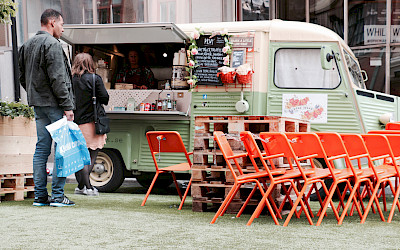
A pop-up area on Stockholm’s Skånegatan developed in collaboration with White Arkitekter. Together, we created a temporary space for meetings, food, creativity and cultivation of plants.
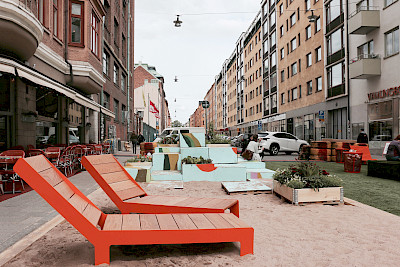
“We are convinced that there are ways to create urban places that do not need to be closed down due when the seasons change – even in Sweden,’ says Henrik Edlund, CEO of Nola. ‘In fact, we have been designing products for outdoor offices for many years, and they are able to remain outdoors all year round. Quality manufacturing and the right choice of materials makes that possible.’
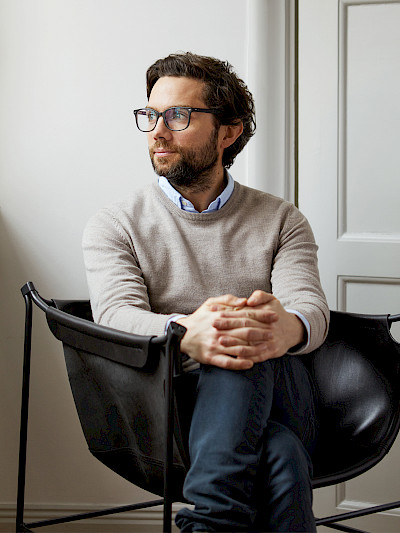
Henrik Edlund, CEO of Nola. Photo: Åsa Liffner
“We are convinced that it is possible to create urban places that don't need to be closed down when the seasons change – not even in Sweden.”
Henrik Edlund, Nola
In Sweden, initiatives such as summer pedestrian streets, pop-up places and playful surfaces have been around for a long time. They are often built from pressure-treated wood or reclaimed freight pallets. They are installed along popular shopping streets and squares, usually adjacent to restaurants or kiosks. Hopefully, new outdoor trends can influence urban development in a positive direction. Temporary parks and green spaces have a lot of value, both for the city itself and the people who use them. None of these values are necessarily tied to a season or limited by the climate. Some are installed privately by property owners for residents’ use, and many are put in place by city administrations for use by the public.
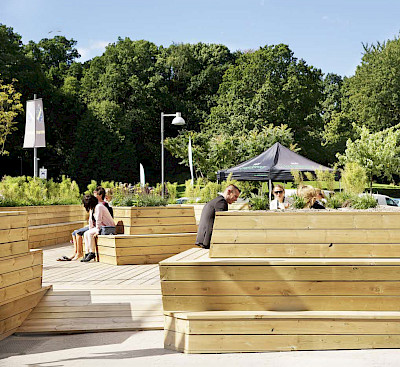
Pop-up parks and pocket parks near Stockholm were initiated by Fabege. They create places for meetings, working outdoors and relaxation. In the winter, they can include rugs and lighting.
“An imperative for creating places where people thrive is to give back to the community.”
Susanna Elvsén, Fabege
‘As we see it, we have a responsibility to create pleasant and experience-rich street spaces around the buildings we lease to tenants,’ says Susanna Elvsén, market area manager at Fabege. ‘It should be safe to walk to the office or shop, and home from the garage or metro station. That’s why we develop places with the ambition that they should benefit everyone. An imperative for creating places where people thrive is to give back to the community. Pop-up parks and pocket parks can be tricky to plan and create, but in the long term, they’ll help to increase the value of individual properties and the neighbourhood itself.’
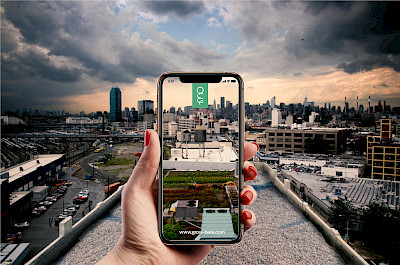
The GrowHere platform can match imaginary green areas with local growers in the early stages of planning and help create long-term and sustainable solutions. Image: The Foodprint Lab
The City of Gothenburg has installed many pop-up parks over the years. Recent initiatives include cultivating plants in collaboration with The Foodprint Lab, an architectural firm passionate about creating connections between growers and landowners. Among other things, they have installed pop-up parks on urban thoroughfares in Gothenburg and transformed a run-down area into a bustling farm where leisure and commerce can come together.
‘We can see evidence of how people are getting better quality of life from cultivating plants in the urban environment,’ says Jonathan Naraine, architect and permaculture designer at The Foodprint Lab. ‘It has positive effects such as making it profitable to transform a green space into a cultivation area because it will encourage biodiversity. Growing edible plants and flowers in the city enriches the soil, enabling it to handle water in ways that make it more resilient to climate change. Studies from San Francisco show that all activities in connection with a pop-up park increase product sales and boost visitor numbers.’
This pop-up park transformed a declining area with high crime rates into a thriving area for cultivating plants and opening small enterprises. Also a 'parklet' in central Gothenburg brings biodiversity into the city centre. Photo: Michael Gykiere

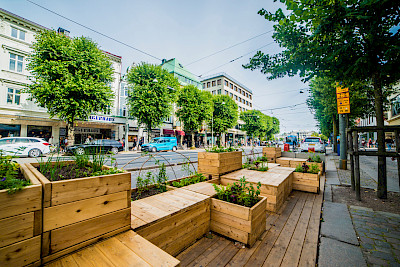
A 'parklet' in central Gothenburg brings biodiversity into the city centre.
Despite the long-term success of initiatives such as these, the majority of them remain seasonal, and therefore temporary. A welcome alternative can be found in green spaces established and maintained by the city’s residents themselves. Victoria Bengtsson is a planning architect at Borgholm municipality who has teamed up with Jonathan Naraine to work voluntarily with GrowHere, an app matchmaking service for growers and property owners.
With an ambition to encourage more cities and even whole regions to introduce urban cultivation, Bengtsson is taking steps to inspire others. ‘Architects like to include cultivable areas in their plans, but they are seldom realized due to the maintenance requirements they bring,’ she explains. ‘Through the GrowHere platform, we can match imaginary green areas with local growers in the early stages of planning, and that way offer a long-term and sustainable situation for customers.’
Jonathan Naraine agrees. ‘The app is used to find out where there are clusters of people or groups interested in cultivation,’ he says. ‘If you plan according to those, the outcomes can be better adapted to markets and demands. It’s a good planning basis for cities and a good resource for citizen-driven green spaces.’

Jonathan Naraine and Victoria Bengtsson work actively with cultivation of plants in all of their architectural projects. Photo: AnnaCarin Isaksson
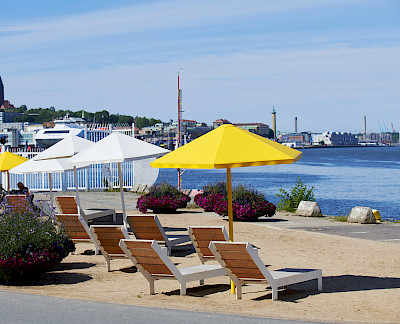
Playa Stenpiren in Gothenburg is a temporary urban beach Nola was involved in developing on behalf of the city of Gothenburg. A carpark was transformed into a sandy beach in the middle of the city.
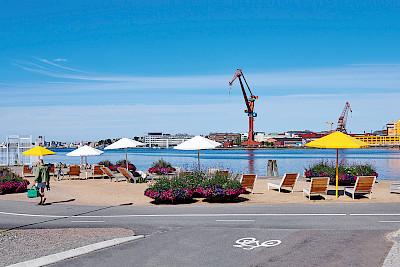
Fresh approaches like these are paving the way for more year-round green spaces. They also indicate that it’s possible to create more permanent green areas and develop more new parks, and all on a much larger scale than before.
Since Paris Mayor Anne Hidalgo came to power in 2013, she has put green politics and urban development first. The City of Paris made an ambitious response to climate change that other cities would like to follow. Following the climate summit in 2015, the city has shown where residents want to stand when it comes to green, lush and sustainable cities. Part of Hildago’s election promise was to plant over 170,000 trees before 2026, and by 2030, 50 percent of the city will consist of green areas. To achieve this, Hildago eased regulations that will make it easier for residents to plant trees in urban neighbourhoods. By 2030, all fossil-fuel car traffic will have been phased out. Many quayside paths along the Seine have been closed to car traffic and over 1,400 kilometres of new cycle paths have been put in place.
Other leading cities have accelerated the development of green urban spaces. Barcelona, for example, has introduced a blueprint for 21 new public squares and new pedestrian-only green lanes. In Milan, street sidewalks have been widened, traffic speeds have been reduced and dozens of new cycle paths now traverse through the historic centre. In New York, a so-called pontoon park ‘Little Island’ has just opened at a site that will regenerate the storm-damaged Pier 54 area hit by hurricane Sandy in 2013. The park, offering visitors experiences of nature and culture, is created by Barry Diller in collaboration with the Hudson River Trust, Heatherwick Studio and landscape architects MNLA.
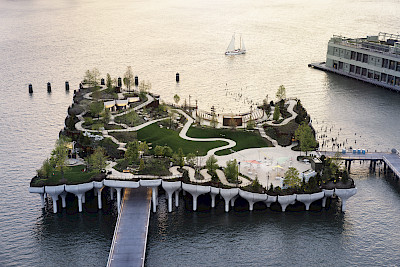
New York has a floating green oasis on pontoons, a place where wildlife, people and culture meet. Photo: Michael Grimm.
Projects such as these reflect changing mindsets in major cities more than they do their climate zones. They also reflect the realization that urban planners can actively reduce carbon emissions impact by planting greenery to absorb CO2 particles.
‘What if Swedish municipalities thought a little more like the mayor of Paris and allowed city residents, property owners, businesses and visitors to literally leave green marks in the cities?’ asks Malin Moreau, creative director at Nola. ‘It's tempting to play with the idea… I mean, what's the worst that could happen?’
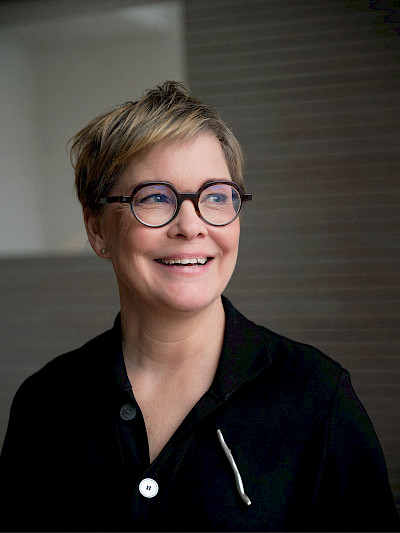
Malin Moreau, Creative Director, Photo: Johan Sundell
“What if everyone was allowed to leave green marks in the cities and in their residential areas — what is the worst that could happen?”
Malin Moreau, Nola
According to the WWF, more and more individuals are feeling committed to climate and sustainability issues. It is to the delight of everyone that environmental awareness is spreading. Imagine that it could be amplified in the development of cities by people allowed to contribute to making them green. In San Francisco, where the pop-up park phenomenon was born, it has become an identity and cultural expression as much as it is a way to give something back to the city and its inhabitants.
‘Just because we have four seasons, we shouldn’t let it limit the solutions,’ says Henrik Edlund. ‘The city's transformation has to take place all year round. We need to be more ambitious about summer pedestrian streets and the potentials to make them year-round and permanent. A pedestrian-only zone park in summer can become a great ice-skating rink in winter. It’s just a matter of investing in durable materials and flexible systems that can withstand both the weather and the ravages of time. We want to see more sustainable green spaces. Both for biological diversity as well as for diverse creativity.’ ●